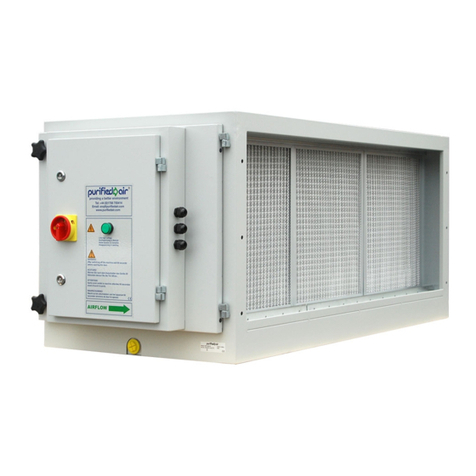
The spigot must be installed at least one metre prior to the fan unit and if possible in a straight
piece of ducting away from bends and other obstructions which will interrupt uniform airflow. The
spigot has an outside diameter of 50 mm therefore you must drill a hole in the ducting to
accommodate the spigot, this is normally done with a tank cutting drill bit. The spigot tip should
be as close to the centre of the ducting as possible, if necessary the spigot can be cut if it is too
long. The angled face of the spigot must face away from the airflow in order to establish a venturi
effect, under no circumstances should the spigot be positioned otherwise as this can cause blow
back and prevent the system from working at all. Once the spigot is in place it should be secured
using self tapping screws through the flange. You will note that the flange is a tight push fit, when
the final position is settled you may wish to fix the spigot to the flange to prevent any movement,
this can be done using good quality PVC glue. The spigot can now be connected to the unit via the
hose provided. Before pushing the hose onto the two connections place the jubilee clips over the
hose. Once the hose is in place tighten two clips over the bottom connection and one over the
spigot connection. Be sure not to over tighten the clips, as this will crack the pipe.
3.2 Commissioning O.N. 100
Now that the system is fully installed turn the fan to maximum and open the damper fully.
Neutralising fluid should now be strongly detected at the exhaust point. To balance the system
correctly wait until the kitchen is busy, neutralising fluid can still be detected then gradually
decrease the output of the unit by tuning the knob anti-clockwise. When both odour and the
neutralising fluid can be faintly detected, the unit is set correctly. Cooking odour may be detected at
the discharge point but if you stand back a meter or so from the end of the duct you will note that
the majority of the cooking odour has been neutralised.
If after twenty minutes operation more than a trace of chemical can be seen in the spigot or the
tube leaving the unit then the velocity is too high. Unless dealing with an extraordinarily odorous
system the chemical is designed to evaporate into the system in very small quantities. To reduce the
evaporation of the chemical close the damper gradually until the optimum setting is found. It may
take some time to find this setting and it is recommended that this exercise be carried out over a
period of a few hours to ensure that the settings are correct.
ON 100 operation instructions:Layout 1 9/5/10 12:44 Page 8




























